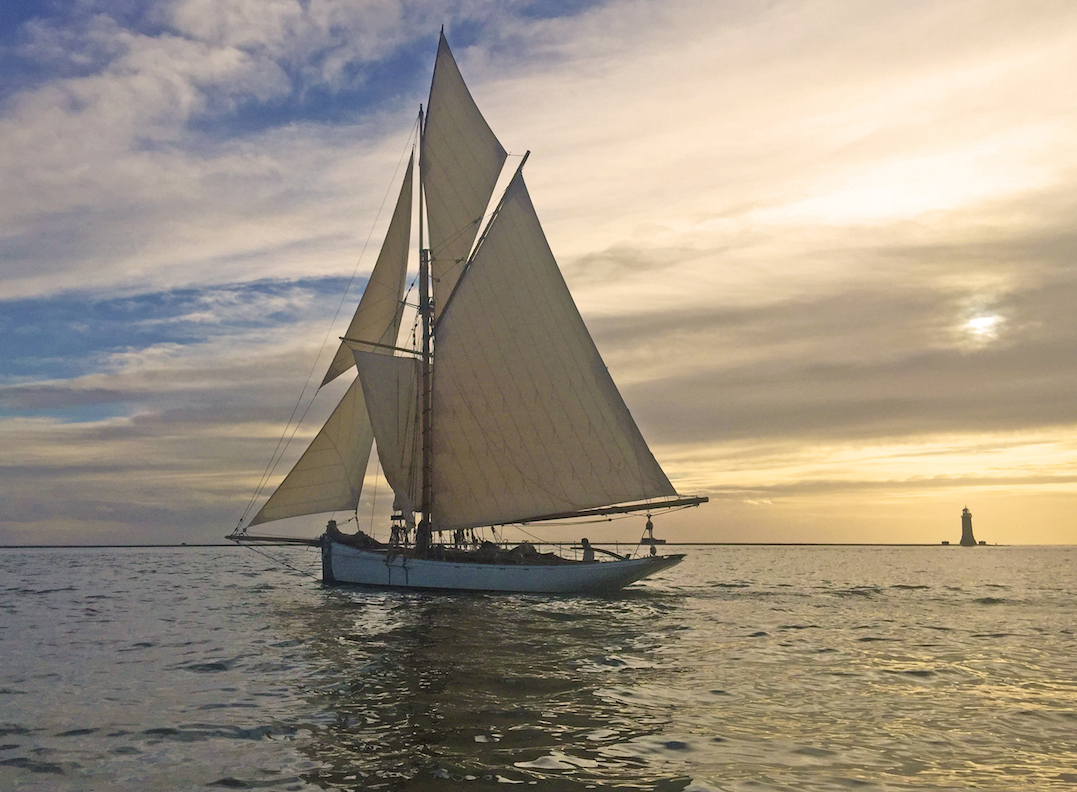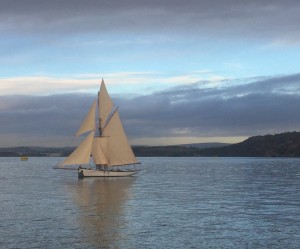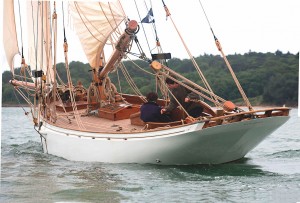by Will Stirling
There are many ways to set a square sail on a sailing boat; this is one of many; simplicity is a virtue.
The following method has four ropes and a halyard.
Two of these ropes are sheets – which it would be difficult not to invite to the party; without the halyard the whole effort will never get off the deck; thus it remains in this brief discourse to reveal the purpose and operation of the ‘other’ two ropes.
The yard lives on deck, port side, in a pair of spar irons. The aft spar iron is a full ring and the forward spar iron, is in the shape of a U, being open at the top. This keeps the spar captive and raised off the deck, allowing water to run off underneath.
The sail remains tied, or bent onto the yard and there is a generous bag which is put on from forward to aft so that the open bag end does not face forward.
The sail has short tack ropes at either end in order to attach the sail to the spar and outhaul it tight. The sail also has a head lacing so that the head does not sag from the spar.
The sail is twice the beam of the vessel and the spar is 18 inches (45cm) longer than the head of the sail. The spar has a single haul yard eye in the centre.
There is a control line tied to the port end of the yard and long enough to reach the deck when the sail is aloft.
Hoisting: There is a tensioning line which is shackled to the forestay, laid over the yard port side of the central eye and long enough to reach the deck when the yard is aloft. Prior to hoisting the bitter end of the tensioning line is tied loosely to the mast spider band.
In order to hoist the sail the ties are thrown off. In truth there is a little less vigour than that as the sail ties are taken off and stowed in the sail tie barrel.
The staysail halyard is connected to the central eye in the spar whilst the spar remains in the spar irons. By pulling down on the staysail halyard the weight of the spar is lifted up.
A hand keeps some pressure on the aft end of the spar whilst the halyard is hoisted, thus more or less cock-billing the yard fore and aft on the port side deck with the pivot point abeam of the mast. As the yard goes aloft the after end is walked forward along the deck until it clears the port rigging at which point it is let fly, allowing the yard to become parallel and set thwartships.
Hoisting on the staysail halyard continues until the yard hangs just below the forestay splice.
The tensioning line (whose end shackled to the forestay has ridden up the forestay with the hoisting of the yard) is then pulled tight to the foot of the mast thus stringing the yard in position so that it cannot bang against the mast.
The control line is loosely tied to the port pin rail.
The sheets then control both the sail and the yard. These can be used to brace the yard right round and even allow the vessel to sail to windward.
Lowering: In order to douse the sail, the control line is pulled down which cock-bills the yard and scandalises the sail.
The staysail halyard is lowered away until the end of the yard comes within reach of the person on the control line. Once in hand the port end of the yard is walked aft and guided into the spar irons.
Here it is in action:
Handling: Whilst initially little understood, Integrity’s square sail has become a much relied-upon part of her rig.
The sail is a lifting sail. There is little chafe and little stress on the rig.
When sailing off the wind in a swell, even with a well steeved boom, the boom is apt to dig into the odd sea to leeward, and then it drags aft in the sea, the mainsheet comes slack and then thumps back into position sending a shudder through the boat as the wind takes charge again. When sailing off the wind there is inevitably some weather helm and when sailing dead down-wind the necessary fear of a gybe. The square sail tows away quietly and is almost its own self steering device.
Now follows a catalogue of errors:
We tried a spreader yard on the foot of the square sail. The geometry of two yards made setting the sail difficult. The spreader yard broke on the way to the Faeroes. We deposited it ashore in a shipyard spar rack, next to the broken parts of a Faeroese smack’s 22in diameter bowsprit. Sight of this mighty broken spar gave the ship’s company cause for reflection about potential local sea state.
We tried Claude Worth’s methods but found there was a lot of rope to handle. Nonetheless on a separate note we all agreed with Claude and repeated in best Victorian dictum that, ‘a cutter’s mainmast must be beyond suspicion’.
We cut two foot (61cm) off the bottom of the sail to allow us to see where we were going; for aesthetic reasons, windows in the sail were not an option.
We tried a bunt or brailing line and found it brailed reasonably well. However, the brailing line was very long when brailed and liable to ‘complex issues’, throwing itself into a paroxysm or tantrum of knotted rope prior to any handling.
We did not want to leave the yard aloft for two reasons; firstly weight aloft should be kept to a minimum; secondly the topmast is regularly housed for ocean work, only being sent aloft when the topsail is set which means that the front of the mast has to be clear in order to allow the topmast to be rove and reeved.
A consideration was to carry the yard spread thwartships and 8’ above the deck thus keeping the weight low yet the working deck space clear. This idea was suggested by paintings of cutters up to the mid-19th century. This was not deemed feasible due to the amount of lines that would be needed to prevent the yard gyrating in a wild and scythe-like manner at sea.
We initially had a hook on the tensioning line which was simply flopped over the forestay. This method was condemned after rounding Langanes, the NE corner of Iceland. On dowsing the squaresail we were naturally upset to see the 24-foot yard and sail sliding down the forestay to deposit itself in the eyes of the boat. With the usual perversity of items afloat, magnified by being aloft and afloat, the hook had hooked itself through the yard’s central eye thus firmly connecting the yard to the forestay. There being nowhere to stand at the pointy end of the boat, it took some delicate action between two men, holding both each other and the forestay, a short sharp knife and the heavy spar, liable to throw itself into the sea as soon as it was disconnected.
Thus through trial and much error, much agonising and thought, two steps forward and the odd leap backwards, we find ourselves with a workable solution. Despite hundreds of years of square sail experience – the accumulation of millions of minds with square sail knowledge; in the 21st Century we have to work it out afresh. This is devolution.
Main image shows: Integrity sailing off her home port of Plymouth trialling the new sail




